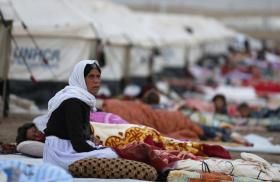
- Policy Analysis
- PolicyWatch 3019
The Future of Regional Cooperation in the War on Terror

Part of a series: Counterterrorism Lecture Series
or see Part 1: U.S. Efforts against Terrorism Financing: A View from the Private Sector
Four veteran counterterrorism experts discuss whether America's alliances with Middle East partners have helped or hindered the fight against global extremism.
On September 14, Matthew Levitt, Stephen Tankel, Tricia Bacon, and Barak Mendelsohn addressed a Policy Forum at The Washington Institute. Levitt is the Institute’s Fromer-Wexler Fellow and editor of its recent compilation Neither Remaining Nor Expanding: The Decline of the Islamic State. Tankel is an associate professor at American University and author of With Us and Against Us: How America's Partners Help and Hinder the War on Terror. Bacon is an assistant professor at American University and author of Why Terrorist Groups Form International Alliances. Mendelsohn is an associate professor at Haverford College and author of Jihadism Constrained: The Limits of Transnational Jihadism and What It Means for Counterterrorism. The following is a rapporteur’s summary of their remarks.
MATTHEW LEVITT
The immediate aftermath of the 9/11 attacks spurred tremendous international cooperation, and a number of tactical counterterrorism successes have been registered since then. The United States has built up its allies’ capabilities, and stronger border protections have been implemented as the national security community shifts to accumulating information on the most dangerous cells and fighters.
Yet tactical success is not enough in counterterrorism; strategic success is needed as well. As Gen. Michael Nagata asked at a previous Washington Institute forum, why is global terrorism more widespread and complex today than it was when the international community began actively combating it?
For example, the creation of the Islamic State (IS) came as a humbling strategic surprise, and while the group no longer holds vast swaths of territory, its “provinces” in various countries remain a problem. Such challenges mean that international cooperation is just as important as ever. Some of the most dangerous terrorist plots of the past few years have been transnational in nature, such as the foiled 2015 attack in Verviers, Belgium, and the 2017 Australian airline plot. Indeed, the transnational nature of the airline industry requires the creation of a counterterrorism legal framework that crosses borders.
While the United States should continue focusing on kinetic efforts to stop new attacks, it also needs to build up its non-kinetic capabilities in order to reduce the population of potential extremists. This means helping regional partners build up their own capacity. Washington has complicated relationships with Turkey, Iraq, the Gulf states, and other governments, resulting in a great deal of tactical counterterrorism cooperation but not much strategic cooperation on countering violent extremism.
Going forward, there are two best-case scenarios for how the “war on terror” could end. The first is the complete collapse of global terrorist movements. In the second, these movements back away from attacks on the West in order to pursue local opportunities. Countering scenario two would necessitate changing the environment to prevent terrorists from gaining a local foothold.
STEPHEN TANKEL
The U.S. policy community is waiting for the Trump administration’s updated document on national counterterrorism strategy. If the past is any indicator, this document will shift the burden of counterterrorism operations to U.S. partners, requiring even more intense coordination with those states. Such cooperation can take four forms.
The first is counterterrorism operations conducted by partner nations, including local law enforcement efforts, military operations to retake territory, and/or financial operations to degrade terrorist infrastructure. These operations can be very difficult for Washington to influence, since they often depend on the relationship the partner nation has with the terrorist group in question. If that relationship is belligerent, then the government will probably conduct counterterrorism operations on its own initiative. Yet if the relationship is collaborative—as seen with Pakistan and the Haqqani Network—then nothing the United States can do will influence the government to take action against the group.
The second form is tactical cooperation with the United States, such as sharing intelligence and allowing access to airspace and military bases. These are issues on which bilateral relations matter more, and U.S. statecraft has more influence. Unsurprisingly, this kind of cooperation tends to be more successful than others.
The third form is seeking help from other countries, such as joining coalitions or requesting diplomatic support for negotiating with various groups. Multinational coalitions are nothing new, but they are increasingly being used for counterterrorism. And while traditional alliance dynamics are important, regional threat perceptions matter much more.
The fourth form is countering violent extremism, which is crucial but also very difficult. States are more willing to launch CVE-specific initiatives such as counter-narratives and deradicalization when they perceive a threat. But they rarely agree to implement CVE-relevant initiatives such as economic reforms and improving rule of law, especially in the Middle East.
The United States needs to spend more time analyzing what it can expect from its counterterrorism partners. Policymakers have understandably been trying to deemphasize counterterrorism operations in favor of great power competition, but that makes effective burden sharing even more important.
TRICIA BACON
Whenever rumors emerge that two jihadist groups might form an alliance or break up, CT analysts tend to focus on similarities or differences between their ideologies, priorities, and strategies. Yet these traits are not good predictors of whether alliances will actually form or dissolve. For instance, when al-Qaeda first allied with Abu Musab al-Zarqawi’s group years ago, they had clear similarities and differences. These traits persisted when they later split up, and they persist today, when the counterterrorism community is debating the possibility (suggested by Bruce Hoffman) of a “CT nightmare” in which al-Qaeda and IS merge back together.
A better predictor of coordination between terrorist groups is the presence or absence of rivalry between them, namely, competition for resources, constituents, or territory. Even if two groups subscribe to the same broad jihadist cause, rivalries can cause one group to see the other’s gains as a loss. And they do not suddenly stop being rivals when they form alliances—rather, these relationships are often temporary, limited in scope, driven by realpolitik, and marked by adversarial behavior, since neither group wants to be in a poor position when the alliance collapses.
In contrast, alliances between non-rival groups tend to be much stronger and more complementary. This usually happens when the groups share a broader cause but operate in different parochial environments, giving them little cause to fear one another. As a result, they often see each other’s gains as mutually reinforcing, and they are more willing to help their partners patch up organizational weaknesses.
In order for Bruce Hoffman’s nightmare scenario to come true, IS and al-Qaeda would have to cease being rivals, but it is difficult to imagine their leaders setting aside their competitive calculus. A much more likely scenario is that the two groups collaborate shallowly as rivals, which would not be as detrimental to U.S. national security.
Cooperation between terrorist groups shapes the counterterrorism landscape, but the CT community has never seriously looked at efforts to disrupt these relationships. It is time to start that conversation.
BARAK MENDELSOHN
Transnational jihadism has been constrained, but the war against it has been only a relative success, since eliminating the problem entirely would require large-scale social engineering in several countries. Accordingly, the United States should rethink its strategy. The counterterrorism community has been overly focused on terrorist attacks rather than the political goals of terrorist groups. This focus is problematic because it encourages civilians to seek complete security from all attacks, which is impossible. More attention should be paid to denying terrorist groups their goals.
In this sense, transnational jihadist groups like al-Qaeda are bound to fail, since their goals involve reshaping the world order around religion and rendering regional differences irrelevant. Most Muslims do not want to live under sharia law, so these groups have limited room for mobilization. And while their lofty goals give them ample reason to unite, their ideological incoherence and clashing egos regularly prevent this from happening. Moreover, their religious vision requires them to carve out territory of their own, but this makes them more vulnerable to military action.
The failure of IS demonstrates how difficult the task of transnational jihadist groups is. The group emerged under the best possible conditions: Syria and Iraq were in chaos, and the United States was in a hurry to leave the region. Even so, IS was eventually overwhelmed. The fact that it was unable to translate its early victories into long-term success shows that such groups will never be able to achieve their broader political objectives.
Since the goal of stopping all jihadist attacks is unreasonable, the United States should pursue a strategy of containment. This approach would be cheaper because U.S. forces would not have to be operationally available everywhere at once. Partner states are currently better positioned to deal with internal threats; they should be given logistical and intelligence support, but no more. America should intervene only when transnational spillovers occur; in fact, it should create a rapid response force for this purpose. Although some might say Washington is already pursuing a policy of containment, it has really only tried to contain jihadist attacks. If it focuses on containing their political goals as well, it can make the United States less of a target.
This summary was prepared by Avi Bass.









